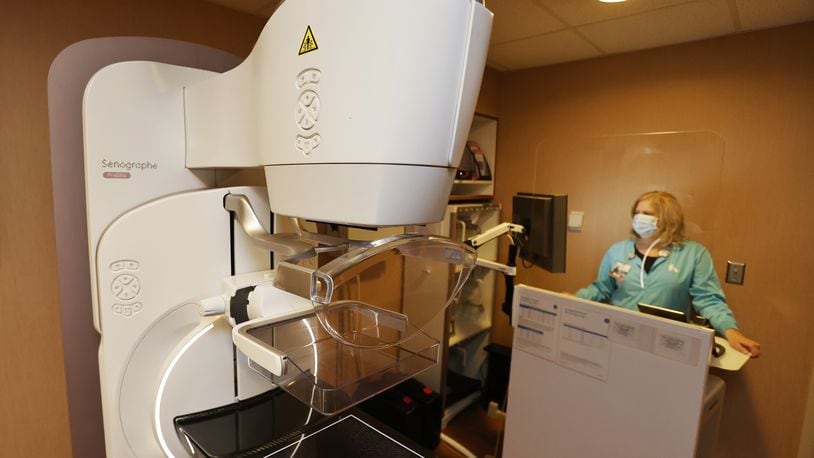“We’ve seen very advanced breast cancer in very young women, so we know this particular population seems to be at risk for breast cancer.”
The creation of the breast center, which accepted its first high-risk patients on July 5, took several years. New equipment was purchased, staff received more training, and programs were certified.
Most importantly, doctors created a new team approach where the breast surgeons, plastic surgeons, medical oncologists and the radiation oncologist coordinate their work.
Dr. Linda Reilman, who championed the hospital’s American College of Radiology Breast Center of Excellence certification, said the hospital bought a state-of-the-art MRI machine about a year ago.
The hospital also has one of southwest Ohio’s first 3D stereotactic biopsy tables.
“Basically, we’re doing everything here that any major breast center would do — we have all the capabilities,” Reilman said.
Not your grandmother’s hospital
“The hospital is not your grandparents’ hospital,” said Kevin Attride, Kettering Hamilton’s director of business development.
While local residents grumbled about the hospital’s name change, Kettering Health leadership believes it lets people know the hospital brings more resources to Hamilton.
With the Breast Center’s team approach, doctors coordinate their work so surgeries and other treatments can happen closely together, and healing should be faster.
“A woman comes in and they get all of their care by the same group,” Lichter said “We try to get it all within the same week, if not the same day.”
Several decades ago the treatment was to remove an entire breast. In the past 30 years, doctors went to only taking parts of the breasts, combined with radiation, and had the same outcomes, Lichter said.
Credit: Nick Graham
Credit: Nick Graham
Using advanced techniques, such as hormone modulation, chemotherapy, and radiation, “we can get your rate of recurrence down to 5%,” which is the same rate as removing the whole breast, he said.
Breast centers have become more common in the past decade. Area hospitals with breast centers or extensive breast care include Premier Health’s Breast Center at Atrium Medical Center; Mercy Health – Fairfield; Christ Hospital’s Mt. Auburn campus and its ambulatory outpatient center in Montgomery; UC Health’s hospitals in Clifton and West Chester; and for TriHealth, at Bethesda Butler and McCullough-Hyde.
A ‘team sport’
Breast teams include a general surgeon, a radiation oncologist, medical oncologist and a plastic surgeon.
“They all have to work together to decide when to start the drugs, when to start the radiation, when is it safe to reconstruct the breast, so it’s not going to just fall apart from all the drugs that are in their system,” Lichter said.
Before the surgeon cuts out the cancer, a plastic surgeon plans how to reconstruct the breast to keep it looking normal. Patients see medical oncologists to receive hormone modulation and chemotherapy if those are needed. Radiation is used to eliminate remaining microscopic cancer.
“That’s where everybody comes together: We resect (cut out), we rebuild, we treat with drugs, and we treat with radiation,” Lichter said.
“In the end, they maintain their sense of wholeness, because you’ve got a much smaller scar,” Lichter said.
Calculations of cancer risks
The hospital plans to prevent cancer is by calculating patients’ lifetime risks.
Mammography patients are asked questions and evaluated for their risk of ever developing breast cancer.
Based on the calculations, they are enrolled in screening programs consistent with the quality care they would get anywhere else, Reilman said.
“We’re trying to see what we can do to bring those numbers down, so that we find breast cancers earlier, we reconstruct more breasts, and we’re able to identify families who are at risk so they can protect themselves and their children,” Lichter said.
Credit: Nick Graham
Credit: Nick Graham
Hamilton Council Member Susan Vaughn, who was born at Fort Hamilton, herself became a breast cancer survivor in the past two years. She was impressed by a recent presentation Lichter gave city officials.
Vaughn wasn’t treated at Fort Hamilton because her doctors were elsewhere, but said she most was impressed with Hamilton’s team approach: “I think that is the most important thing in dealing with a cancer of any kind — and I don’t know a lot about other cancers.”
“Everything that they described was everything that I experienced positively, although it was not there,” Vaughn said. “And to have it right here in Hamilton is amazing.”
Lichter said the proximity can make a big difference for patients, even those with good transportation.
“When you’re having to drive from Hamilton down to the University of Cincinnati, it’s a big deal,” he said. Even though it’s a smaller hospital, “We’re able to offer a pretty high level of care, here at home.”
Nick Graham contributed.
Credit: Nick Graham
Credit: Nick Graham
About the Author
